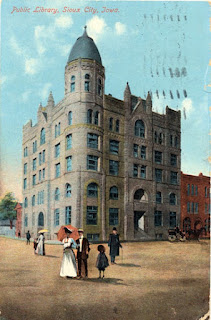As a collector of postcards featuring libraries, I seek out those that are less typical. Few are less typical than those that have a winter holiday theme. Here are a few in my collection.
What is the Santa on this 1910 postcard featuring the Cossett Library in Memphis, TN thinking?
This postcard featuring the Santa Rosa, CA public library was mailed on Dec. 24th, 1909. It was published by Richard Behrendt of San Francisco. I have several of Behrendt's California library holiday cards.
This postcard was mailed on Dec. 24th, 1920 and features the George Maxwell Memorial Library in Rockville, CT.
This multi-view postcard for Boise, ID was probably enclosed in an envelope when it was mailed in 1909 since it has a message but no stamp. It includes an image of the Carnegie Library.
Robert H. Lord of Boston, MA published postcards with original messages and illustrations. This one was mailed on Dec. 18, 19ll from Molin, IL and has a message about public libraries.
A dramatic postcard featuring an angel and the Binghamton, NY public library. It was not mailed.


















































